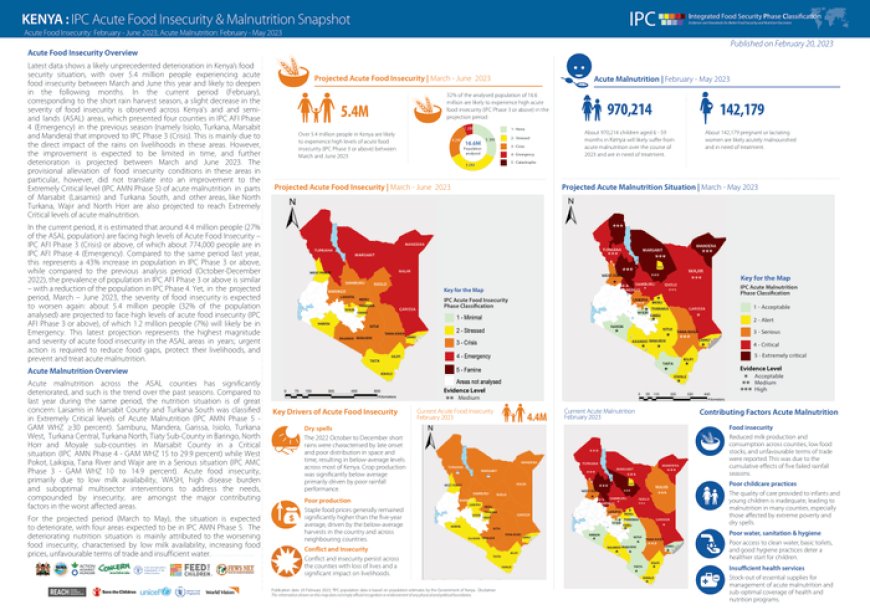Kenya’s IPC Report 2023: Drought-Related Acute Malnutrition & Food Insecurity in ASALs.

The Integrated Phase Classification (IPC) report for 2023 in Kenya paints a grim picture of the country’s food security situation. The report highlights the devastating impact of drought on the country’s food security, with acute malnutrition levels reaching alarming levels. The report also highlights the need for urgent action to address the underlying causes of the crisis, including the need for improved access to food, water, and health services. This article will explore the findings of the IPC report and discuss the implications for Kenya’s food security.
Currently, approximately 4.4 million people( 27% of the ASAL population) are battling high levels of acute food insecurity. An estimate of 774,000 is already in the emergency bracket. ( IPC AFI Phase 4). The severity of food insecurity in Turkana, Isiolo, Mandera and Marsabit counties slightly reduced from IPC AFI Phase 4 in the previous season to IPC Phase 3. This improvement is attributed to the direct impact of the short rains that were experienced in these areas. However, the situation is bound to deteriorate from March to June 2023. Approximately 5.4 million people (32% of the population analyzed) are projected to encounter high levels of acute food insecurity (IPC AFI Phase 3 or above). 1.2 million people (7%) will likely be in Emergency (IPC AFI Phase 4). Parts of Marsabit (Laisamis) and Turkana South and other areas, like North Turkana, Wajir and North Horr, are projected to reach Extremely Critical levels of acute malnutrition. The current projection reflects the highest magnitude and intensity of acute food insecurity in the ASAL regions in years.
Kenyan arid and semi-arid lands have always been in the limelight for extremely high cases of acute malnutrition. According to the report, the situation is worsening. The nutrition situation is deteriorating compared to the same period last year. Of particular interest are two regions, Laisamis in Marsabit County and Turkana South, which were categorized in the Critical level of acute malnutrition (IPC AMN Phase 5 - GAM WHZ ≥30 percent. Samburu, Mandera, Garissa, Isiolo, Turkana West, Turkana Central, Turkana North, Tiaty Sub-County in Baringo, North Horr and Moyale sub-counties in Marsabit County are in the Critical phase (IPC AMN Phase 4 - GAM WHZ 15 to 29.9%), whereas West Pokot, Laikipia, Tana River and Wajir are in the serious phase (IPC AMC Phase 3 - GAM WHZ 10 to 14.9%).
Causes of food insecurity
Kenya's ASAL has been combating droughts marked by below-average, poorly distributed, short-lived rain seasons for the fifth successive time. This resulted in below-average crop production and poor livestock conditions.
Food prices rose significantly while most vulnerable households experienced a drop in purchasing power, and terms of trade reached a seasonal low. Seven out of 23 counties, primarily made up of pastoral communities, have been hardest hit. Samburu, Tana River, Turkana, Garissa, Mandera, Marsabit and Wajir all have 45% or more of their population in either IPC Phase 3 (Crisis) or worse. This has been compounded by conflict across Kenya - especially in Turkana, Marsabit, Baringo, Laikipia and West Pokot - leading to human fatalities and the loss of resources and herds.
There are also factors contributing to this problem, including poor infant and young child feeding practices, a high disease burden, and a lack of coverage for multi-sectoral interventions. Malnutrition is further hampered by recurrent and multiple shocks. Over the next year, nearly 970,000 children 6 - 59 months and 142,000 pregnant and lactating women (PLW) will require treatment
Other contributing factors include low milk availability, WASH, a high disease burden and suboptimal multisector interventions to address the needs. In order to reduce food gaps, protect livelihoods, and prevent and treat acute malnutrition, immediate action is needed.
Kenya: IPC Food Security & Malnutrition Snapshot - Acute Food .... https://reliefweb.int/report/kenya/kenya-ipc-food-security-malnutrition-snapshot-acute-food-insecurity-february-june-2023-acute-malnutrition-february-may-2023
Kenya: IPC Acute Food Insecurity and Acute Malnutrition Analysis .... https://opensourcebiology.eu/2023/02/21/kenya-ipc-acute-food-insecurity-and-acute-malnutrition-analysis-february-june-2023-published-on-20-february-2023-kenya/







